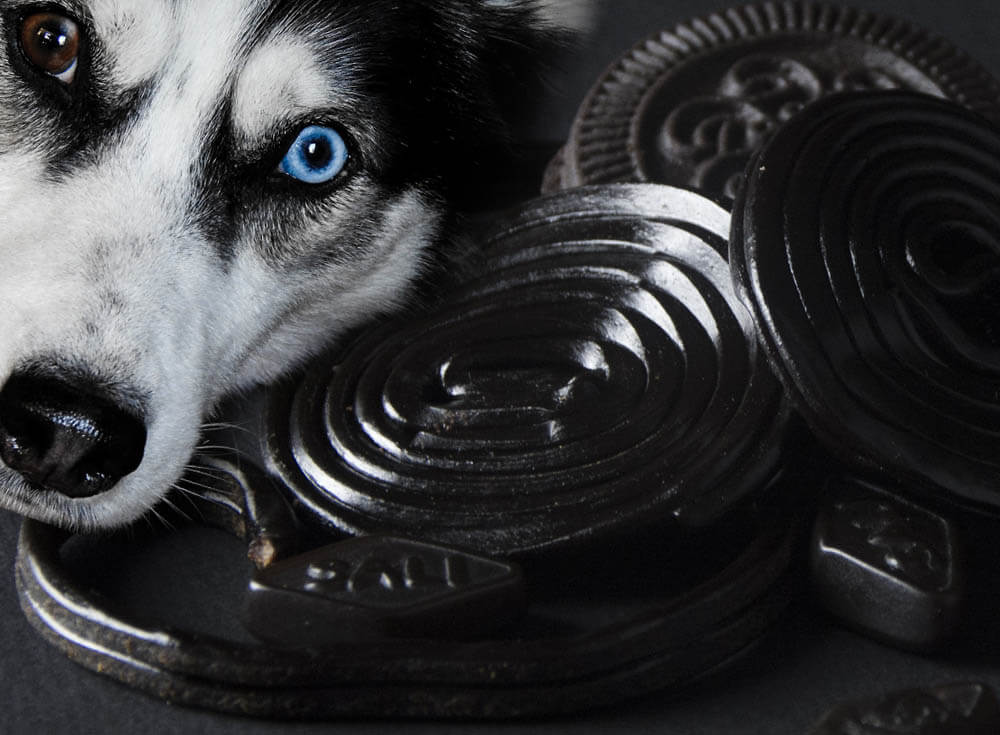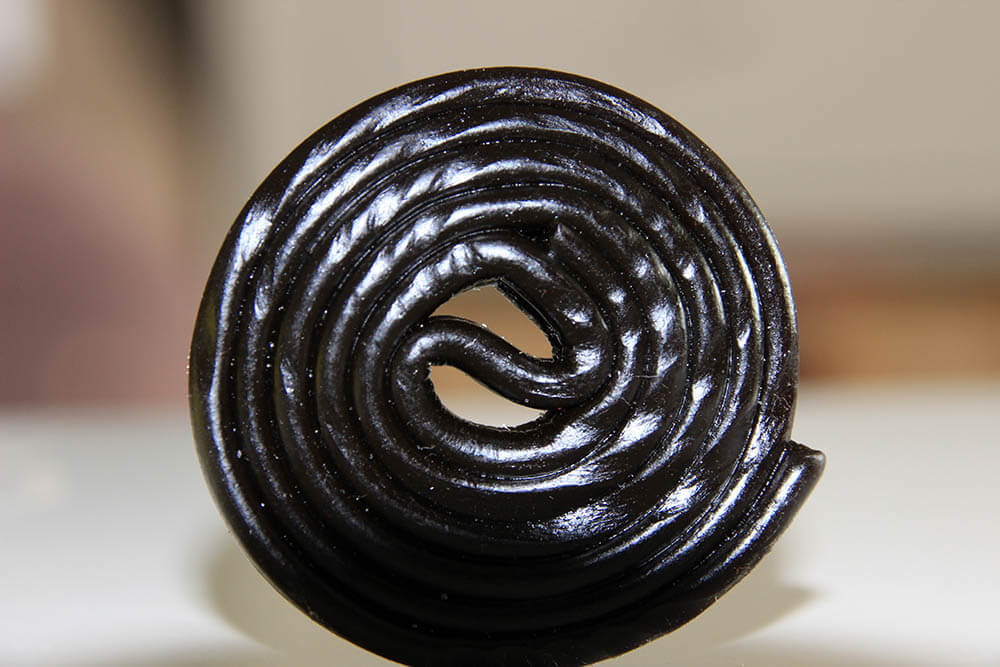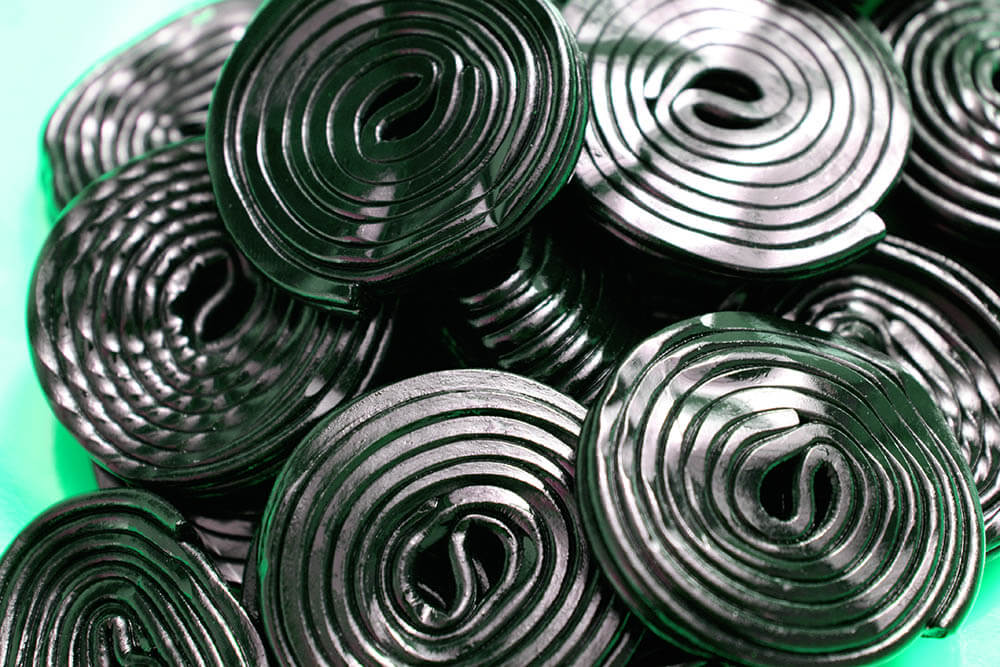Who can resist the sweet, chewy charms of licorice candy?
Probably not your dog. Which is unfortunate, because licorice is bad for dogs.
Yes, licorice candies aren’t the healthiest treats a dog can eat. In fact, they can cause major problems if eaten regularly or in large amounts.
So why is your fur baby better off not chewing on licorice? Read on to find out!
Note: the term “licorice” also refers to the licorice plant, Glycyrrhiza glabra. For simplicity’s sake, we’ll be using “licorice” to refer to licorice candy.

Is Licorice Bad for Dogs?
There are many types of licorice, and all of them are unhealthy for dogs. To know the reason why, we have to examine their ingredients.
Sugar
Sugar is one of the major components of licorice candy.
Unfortunately, this is the unhealthy type of sugar that doesn’t always agree with dogs. So if your dog eats sugar-rich licorice, they may experience gastrointestinal concerns such as:
- Gas
- Vomiting
- Diarrhea
- Stomach pain
These issues may range from mild to moderate depending on your dog’s sugar tolerance. Make sure you seek veterinary help if licorice causes your dog persistent suffering.
Frequently feeding your dog sugar-rich licorice can have terrible long-term consequences, as it could lead to:
- Obesity (which increases the risk of heart disease, diabetes, and osteoarthritis)
- High blood sugar levels (which increases the risk of kidney disease, stroke, and heart disease)
- Pancreatitis
- Dental problems (e.g. cavities, tooth loss)
- Sugar addiction
- Poor appetite (leading to malnutrition)
If you want to prevent the occurrence of these problems in your pooch, you should refrain from feeding them sugar-rich licorice.
Glycyrrhizin
Licorice naturally contains a sweet-tasting chemical called glycyrrhizin, whose anti-inflammatory properties make it ideal for treating allergies, arthritis, and other health issues.
While consuming small amounts of glycyrrhizin won’t harm your dog and may even benefit them, large amounts can cause the following issues:
- Heart problems
- Kidney issues
- High blood pressure
- Shortness of breath
- Fatigue
- Weakness
- Edema (swelling)
- Weight gain
These problems can occur not just in dogs but people, as well.
Xylitol
Sugar-free licorice varieties are sweetened using artificial sweeteners, among the most common being xylitol, a chemical that’s dangerously toxic to dogs.
Xylitol doesn’t discriminate: it can harm a dog regardless of their size, age, sex, or breed. Even a tiny amount of xylitol can kill a dog.
Xylitol poisoning results in the following symptoms:
- Upset stomach
- Decreased activity
- Exhaustion
- Weakness
- Incoordination
- Staggering
- Shivering
- Seizures
- Collapse
- Unconsciousness
These symptoms typically manifest around 10 to 60 minutes after a dog consumes xylitol. However, it’s possible for a dog to show no signs of trouble for up to a full day. For this reason, you shouldn’t assume your dog hasn’t been poisoned just because they haven’t experienced any problems yet.
If ignored, xylitol poisoning can cause liver damage, liver failure, a coma, and even death. For this reason, you should contact a pet clinic immediately if your dog eats xylitol-containing licorice.
Wheat flour
Licorice candies usually count wheat flour among their ingredients, and it just so happens wheat is among the most allergy-provoking ingredients a dog can eat.
If your dog is allergic to wheat, eating licorice can induce symptoms such as:
- Vomiting
- Diarrhea
- Lethargy
- Asthma-like symptoms
- Sneezing
- Inflamed ears
- Itchy skin
- Excessive scratching, licking, and/or chewing of the paws and other body parts
- Rubbing the face on a surface (e.g. the carpet)
- Seizures
Take your dog to the vet if they exhibit the above symptoms after consuming licorice.
Cocoa powder
Some licorice varieties use the ingredient cocoa powder, which contains theobromine. Theobromine is highly toxic to dogs.
A tiny piece of licorice may not have enough theobromine to hurt a dog, but why risk your pet’s life when there are so many healthier options they can enjoy (such as carrots and cucumbers)?
If your dog ingests an entire package’s worth of licorice, they may end up suffering from theobromine poisoning, whose symptoms include:
- Vomiting
- Diarrhea
- Pacing
- Excessive panting
- Excessive thirst
- Increased urination
- Rapid heart rate
- Shivering
- Seizures
- Heart failure
Contact a vet for help if your dog displays these symptoms after eating licorice with cocoa powder.

FAQs About Licorice for Dogs
It’s time to answer more commonly asked questions about licorice for dogs!
My dog ate licorice. What should I do?
Stay calm and determine how much licorice your dog ate. You should also examine the candy’s food label to determine whether or not it contains toxic elements such as xylitol and cocoa powder.
If the licorice your dog ate has toxic ingredients, call the vet immediately. Inform them about what you’ve discovered and any worrying symptoms you may have noticed. Do whatever the vet says; if they say your dog needs emergency treatment, rush them to the vet. Their life depends on it.
If your dog ate licorice without toxins, keep an eye on them. There’s a good chance they’ll be fine if they didn’t eat too much. Expect problems such as vomiting and diarrhea if they ate a significant amount. Either way, it’s a good idea to call a vet to ask them for advice about what to do next.
You should also contact a vet for help if your dog has an allergic reaction to licorice.
If you can’t reach any pet clinics or hospitals, those in North America can call the Pet Poison Helpline at (855) 764-7661 or Animal Poison Control at (888) 426-4435.
Is licorice bad for all dogs?
Licorice with xylitol and other toxins is terrible for all dogs as said toxins can kill them. Sugary licorice candies likely won’t harm dogs if eaten in small quantities, but they can cause long-term damage if consumed frequently and/or in large quantities.
Any type of licorice can harm pregnant and nursing dogs, and dogs with health conditions such as diabetes, cardiovascular disease, and kidney disease.
What is the difference between black licorice and red licorice?
Black licorice is a candy that contains licorice extract – the part of the licorice plant that serves a variety of purposes, such as flavoring and a treatment for joint pain.
Red licorice is a fruit-flavored candy that doesn’t contain licorice extract. Red licorice is licorice in name only.
Can dogs eat black licorice?
You shouldn’t feed your dog black licorice.
These candies typically contain surplus sugar, which can cause digestive issues such as vomiting and diarrhea. If consumed regularly, it can lead to more serious issues such as obesity (which increases the risk of diabetes and heart disease) and pancreatitis. While a tiny amount of sugar-rich black licorice may not harm your pet, it’s still an unhealthy treat they can do without.
Black licorice candies may also contain more dangerous substances. For example, even a small amount of xylitol can lethally poison your dog, while wheat flour can cause a severe allergic reaction.
Can dogs eat red licorice?
No. Because red licorice candy is sugar-dense, it can cause gastrointestinal issues such as stomach pain, gas, diarrhea, and vomiting. It’s possible for a small amount to not harm your pet, but it’s not a good idea to take that risk.
Then there’s sugar-free red licorice which uses an artificial sweetener called xylitol instead of sugar. Xylitol is highly toxic to dogs; even a small amount can threaten your pet’s life.
Can dogs eat Twizzlers?
Hershey’s Twizzlers are licorice candies that don’t contain licorice extract.
They’re extremely high in sugar, which is bad for dogs. Your dog’s sugar tolerance will determine the effects of consuming a bit of sugar; either it won’t harm them, or it’ll give them digestive problems such as gas, stomach pain, vomiting, and diarrhea. And if sugar is eaten regularly, your dog could become obese, making them more likely to develop diabetes and heart disease.
Can dogs eat Red Vines Licorice Twists?
Red Vines Licorice Twists are licorice candies that contain licorice extract.
These candies are unhealthy for dogs due to their high sugar content. Small amounts of sugar may not significantly harm your dog, but they can still give them digestive discomfort if they have a low tolerance for sugar. Large amounts can result in issues such as pancreatitis, dental problems, sugar addiction, and obesity (and associated risks such as heart disease and diabetes).

Conclusion
If you want your dog to stay healthy and happy, avoid giving them licorice candy.
Licorice contains substances that can make your dog ill. Sugar can cause everything from diarrhea and stomach pain to obesity and related health risks. Large amounts of glycyrrhizin can adversely impact the heart and kidneys. Then there’s xylitol and cocoa powder, both of which can kill dogs.
Let licorice stay what it is: a sweet treat meant for humans.
